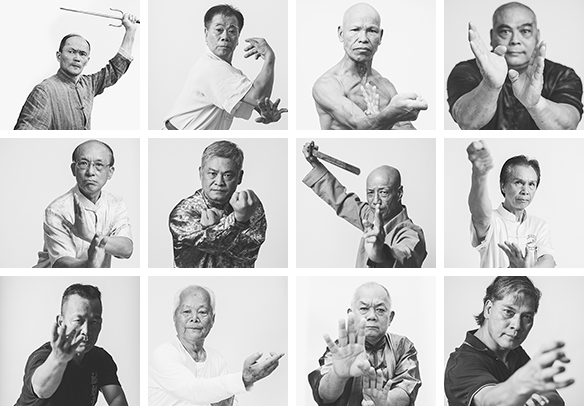Lui Hok Keung, Hakka, was born in Hong Kong in 1962. His family came from Ping Hoi Bik Gaap, Fui Yong county (now under the administrative region of Fui Tung) in Guangdong province. His grandfather was a merchant (he had a merchant fleet that sailed to Hong Kong for trading) and was put in prison during the Cultural Revolution. Later rescued by his son (Lui Hok Keung’s father) the whole family then fled to Hong Kong. Lui Hok Keung was the fifth in his family. He works as a physiotherapist at a special needs school.
呂學強,客家人,1962年香港出生,祖籍廣東惠陽(現規劃為惠東)平海碧甲。由於祖父經商(在惠東擁有漁船到香港經商),文革時期鬥地主,被定為黑五類關起,他父親設法營救祖父後舉家偷渡到香港。呂學強在家中排行第五,現在在一所特殊學校當職業治療助理。
Sau Kei Wan was a chaotic place in the 1960s and 70s. Lui Hok Keung lived in the Nam On Fong neighbourhood which was a shanty town. His elder brother Lui Hok Yeung is older by six years and was the first of the two brothers to study with Lui Chun sifu, master of Fui Tung Ching Lung Tam Hakka Hung Kuen. Lui Hok Keung began martial art training when he was eight. During the war, Lui Chun and his four martial art brothers took refuge in Hong Kong. Lui Chun drifted from place to place and lived for a short period in Cheung Chau, Ping Chau and Stanley, before finally settling down in Nam On Fong village in Sau Kei Wan, where he opened a martial art school. Lui Hok Keung studied martial arts at this school with around ten other villagers (mostly Hakka), who were all roughly the same age. At first a senior student taught them the basics, including three months of stance practice, followed by zik tau teoi, then other basic stretching exercises, and finally practice of boxing sets, such as Sei Mun, Yee Mun, Hai Zai Sei Niu and Hau Zi Saai Lim, two-person training sets such as Deui Zong, Sau Zong, Gwan Zong, etc., and a range of Hakka weapons such as iron rulers and lau zam. Lui Chun had branches in Stanley and Ping Chau as well, but as he was taciturn and spoke little during class.
1960至70年代筲箕灣的環境比較混亂,呂學強住在南安坊山頂木屋區23。哥哥呂學揚年長六歲,較早拜惠東青龍潭客家洪拳盧春師傅為師,呂學強八歲時父親亦帶去學拳。戰亂時期,盧春共五師兄弟逃避戰火來港,期間盧春曾居住於長洲、坪洲、赤柱、最後在筲箕灣南安坊村定居及授徒。武館就在村內,他跟十多個與自己年齡相約的朋友一起練(大部份為山村的客家人)。最初由師兄教,先紮馬三月,後學直頭推,接着是其他拉筋的基本動作,然後才練四門、二門、蛤仔射尿、猴子洗臉等拳套,對樁、手樁、棍樁等拆,及鐵尺、柳針等各種客家兵器。盧春當時在赤柱及坪洲有分館,由於性格沉默寡言,在武館很少對學生作太多解說。
Lui Chun was also a master of Hakka unicorn dance from the Fui Tung region. In the 1970s as a proper paper-marché unicorn head commanded a handsome price (around eight thousand Hong Kong dollars), beginners practiced with a bamboo basket, and only used a real unicorn when they had gained some level of proficiency. In order to enhance unicorn dance’s entertainment value, Lui Chun introduced a series of changes in the 1970s such as increasing the size of the unicorn’s head, which made it easier to perform a figure of eight, put light bulbs in its eye sockets, and increased variations in stances – high, middle and low – with the low stance being the most important. On the eighth day of the fourth month each year (in the agricultural calendar), all the villagers accompanied unicorn dancers in their procession from the village to Tam Gung temple on Sau Kei Wan Tung Street. This tradition is preserved to the present day and remains an important part of the local Hakka community life. Besides performing at the Sau Kei Wan Tam Kung temple, Lui Hok Keung also took part in unicorn processions and kung fu performances (collectively known as “chut pang”) in Ping Chau, Cheung Chau and Stanley.
盧春同時精於惠東的客家舞麒麟。由於七十年代紙紮客家麒麟價格非常(港幣八千元),初學時拿一個籮代替麒麟頭,練熟後才使紙紮麒麟頭。為了提升麒麟的表演性,盧春早於七十年年代把麒麟的尺吋加大了,方便舞八字,眼晴裝了燈,樁法亦調整為高、中、低,但仍以低樁步法為主。每年農曆四月初八日,全村村民一起舞麒麟落山到筲箕灣東大街的譚公廟賀誕巡遊祈福,直至現在仍保留著這項傳統,該區客家人十分重視。當時呂學強除了在筲箕灣譚公誕做表演外,每逢天后誕、南宮誕等神誕,亦還會到坪洲、長洲、赤柱出棚賀誕(出棚指一連串客家麒麟及功夫表演)。
Lui Hok Keung is passionate about the martial arts. Ten years ago he began studying Yang Family Taijiquan and Baguazhang, and is a certified martial art instructor with Hong Kong Wushu Union. His main reason for learning Taijiquan was to attain greater balance between hardness and softness, as Ching Lung Tam Hakka Hung Kuen is quite a hard style. This serves the same purpose as unicorn dance with its flexible footwork.
呂學強熱愛武術,十年前開始學習楊氏太極及八卦掌,現時考取香港武術聯會的教練認證。他練太極拳的目的為了進一步達到剛柔平衡,以便彌補青龍潭客家洪拳過於硬朗之嫌,這跟習麒麟有異曲同工之妙。
In 2000 he started to assist his elder brother in teaching and running his martial art school (at Sau Kei Wan Agricultural Business Association), while continuing to work on and improve his own practice. His wish is to continue the legacy of Hakka Hung Kuen and, in particular, Lui Chun sifu’s lineage.
呂學強從2000年開始當助教,幫助哥哥呂學揚打理武館(筲箕灣農業工商聯會設班),期間繼續跟從哥哥深造功夫。呂學強希望把盧春師傅的客家洪拳發揚下去,以免拳術失傳。





